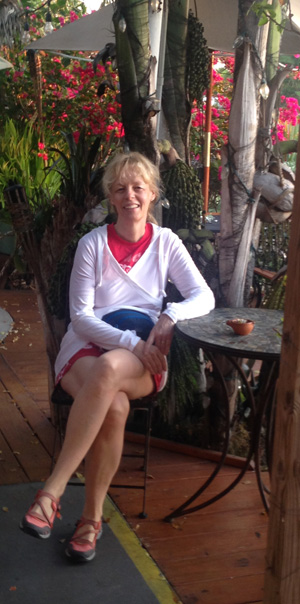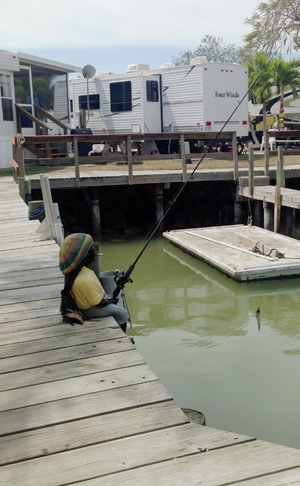
 |
Friday morning and it is snowing. Again. Eleven straight weekends of snow storms, which to be honest has been a blast, but now towards the end of March we are ready for spring to be sprung. Some of us have been ready for a while now. But hey, is there really a better way to set off for (our first) winter's warm-weather break, than a nice gentle snow storm? As long as the plane can land and take off of course. Which it does, right on schedule. Three hours later we were in shorts territory as requested. And by Saturday morning we were sitting outside ordering breakfast at The Havana Cafe in Chockoloskee. But I'm getting ahead of myself. Orlando is one of those cities that takes forever to get away from. After 40 miles and more than an hour we were still in an endless parade of crappy strip malls necessitating a light every 400 yards and each light held up the main road traffic for two minutes or more. Naturally it is not possible for any of them ever to be green. Eventually the lights and the strip malls started to thin out, then there was some arable land between the townships and finally we were into the orange groves. Miles and miles of oranges. The townships were replaced by shanty villages of mobile homes at regular intervals among the groves. Each was more decrepit than the last. The mildew on the outside gave them a dusty, abandoned look, but the occasional car, or washing on a line indicated that they were still in use. The really dead ones were parked together too close to get a door open, and generally leaning over at a perilous angle which presumably prevented them from being put to practical use. Wherever there was a) any sort of water channel next the road b) a ribbon of dirt to park on c) no fencing, there were fishermen. |
 |
 Every so often we passed an ancient school bus, their frequency implied that they were somehow in service. Together with the amount of fruit on the trees we reasoned that the mobile homes were temporary housing for migrant workers, and the busses were their transport. Of course the mobile in the name was not what made them temporary, it was the fact that the migrants only used them for part of the year before moving on. Likewise the bees, who's hives were stacked up on the side of the road for easy access. At least when they moved, they took their homes with them, moving gradually up the east coast on their trailers, some going as far as Maine before repeating the cycle.
Every so often we passed an ancient school bus, their frequency implied that they were somehow in service. Together with the amount of fruit on the trees we reasoned that the mobile homes were temporary housing for migrant workers, and the busses were their transport. Of course the mobile in the name was not what made them temporary, it was the fact that the migrants only used them for part of the year before moving on. Likewise the bees, who's hives were stacked up on the side of the road for easy access. At least when they moved, they took their homes with them, moving gradually up the east coast on their trailers, some going as far as Maine before repeating the cycle.
Eventually we reached the Everglades. Or more accurately Big Cypress National Preserve was to the east of the road, and the Florida Panther National Wildlife Refuge was to the west. Dramatic signs warned of Panther Crossings. Less romantically also known as cougars or mountain lions, according to Wikipedia, in 2013 there were only about 160 still in the wild, so we counted our chances of turning one into road kill as slim. The 10 ft high fence running the whole length of the Refuge diminished our chances further. Open water, stands of tall trees, areas that looked like salt grass, there was no knowing what the flora was going to be like. Five minutes of one followed by five minutes of another. Most remarkable was the difference between one side of the road and other, as if it was some sort of geographical divide.
There were so many cars on the side of the road with their hoods up that we speculated that this must be some signal or other—it made no sense that this number of folks were broken down—and it wasn't like the vehicles were that old, or the weather that hot. We never did figure out the mystery. 210 miles and 4.5 hours after pulling out of the rental lot in Orlando, on the advice of the innkeeper we made a brief stop in Everglade City to pick up a cold six-pack, and 20 minutes later we pulled up outside our motel room in Chokoloskee. Couple of beers on the stoop and we were done for the night. Saturday We sat on the front stoop, and watched the world go by, or more accurately watched it park up front and head inside. The scrawny old bird of a waitress could not have been a day under 70 but clearly was still perfectly capable of dropping you with a single punch no matter how big you thought you were. Or a one-liner. CMT: "See? I'm being bitten up already" Coffee of course. I had a "Cuban" scramble with a side of chorizo, and Claudia had an omelette with a heart-stopping slab of cheese melted into it. But really the highlight was sitting outside in the sunshine and 75 degrees at 7:30 in the morning. |
 |
Sightings on our Ecotour Royal Tern Manatee (just a shadow) |
 We needed to be on parade at the Everglades Area Tours headquarters for our Boat Assisted Kayak ECO Tour no later than 8:30am. We were introduced to Captain Josh and his mate (in every sense of the word) who were young enough to be our kids and the only other participants, Bill and Lucia Shaw who were our vintage. Bill and Lucia were clearly okay, and Bill and I took the rear gunner positions for the golf cart ride down to the boat. Bill asked if there was a head on board, but that was moments before we pulled up at the dock. That would be "no" then. The kayaks occupying the front 60% made it look like a landing craft, but they actually meant it didn't have to be—we would use the kayaks to storm the beach.
We needed to be on parade at the Everglades Area Tours headquarters for our Boat Assisted Kayak ECO Tour no later than 8:30am. We were introduced to Captain Josh and his mate (in every sense of the word) who were young enough to be our kids and the only other participants, Bill and Lucia Shaw who were our vintage. Bill and Lucia were clearly okay, and Bill and I took the rear gunner positions for the golf cart ride down to the boat. Bill asked if there was a head on board, but that was moments before we pulled up at the dock. That would be "no" then. The kayaks occupying the front 60% made it look like a landing craft, but they actually meant it didn't have to be—we would use the kayaks to storm the beach.
We'd barely cleared the dock when your's truly spotted a bald eagle—no, really—Captain Josh even circled back to make sure there was no mistake. We putzed on out. Within minutes everything looked exactly the same. Small islands big islands every island 15 feet high in mangrove, and then more islands. The water was only two to eight feet deep, and the tide made all the difference, so Captain Josh told tales of capturing an unmanned boat, and then later finding its sheepish-looking pilot (who was too embarrassed to give his name) now up to his chest in water but still standing on the sandbank he'd beached up on a couple of hours earlier to fish. The boat floated away when he wasn't looking. A couple of times even Captain Josh had to reverse back out of a miscalculation.
 We kept stopping to watch something or other, and then moving on again, but I think mostly we were all just basking in the quiet, the mirror-smooth water, the parade of wildlife, and the documentary narration, while we just coasted along in a mental neutral, not needing to care where were were, or how, or when, we'd get back.
We kept stopping to watch something or other, and then moving on again, but I think mostly we were all just basking in the quiet, the mirror-smooth water, the parade of wildlife, and the documentary narration, while we just coasted along in a mental neutral, not needing to care where were were, or how, or when, we'd get back.
We stopped to watch a cormorant struggling in the water. "I think he's got a catfish, and they put up a good fight" predicts Captain Josh, and sure enough he drops it several times, trying to get a different grip, and in the end has to give up. Osprey swooped and brown pelicans crashed. One osprey flew by with catch in tow, and after one particularly dramatic pelican splash Captain Josh says "misjudged how shallow the water was."
As we got further out, and the water got a little deeper and a lot more salty, we started seeing more interesting specimens under the water. Small rays and sharks, and some claim we saw some manatees, but I would say we saw evidence that they were probably in the water rather than actually laying eyes on anything. Much more spectacular, memorable, and ultimately recordable, were dolphin. By gently sidling up to them, and then accelerating away, Captain Josh was able to get them to chase the wake. Fab-u-lous.
Wave your mouse over the picture (or black box) above, and a start button should appear. Press it.
Captain Josh was at great pains to explain that interacting with the wildlife in this way was a big no-no, and it was in fact just an accident that the dolphins elected to use the wake to frolic in. Fair enough. Even more fabulous. Eventually we dropped anchor just off an island with a sandy beach. Claudia does not like pushing her rotator cuffs, so we shared a kayak and the others all took singles. We chased the pelicans for a bit, and then beached the kayaks for a stroll along the shoreline. We picked through various shells including a horseshoe crab, but the highlight was when Captain Josh showed us that the rope-like seaweed that had washed up was in fact two different forms of shellfish hatchery. Each little pocket contained a dozen or so miniature shells, each no more than an eighth of an inch long. There must have been thousands, even tens of thousands of them in the whole rope.
By the time we got the kayaks stowed again, we'd already been out longer than the tour advertized, so though we didn't rush home, we didn't dawdle either. Once again I marvelled at how one could navigate around and through these thousand identical islands, but soon enough the dock appeared and that was that. What a great time, but more important, Claudia LOVED it. An instant convert to the joys of ecotourism. May there be many more. We spent the rest of the day racing across Florida, and then down the length of the Keys, not arriving in Key West until dusk.